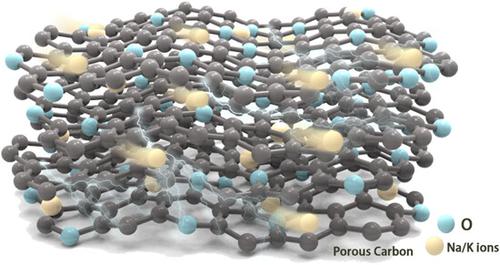当前位置:
X-MOL 学术
›
Carbon Energy
›
论文详情
Our official English website, www.x-mol.net, welcomes your feedback! (Note: you will need to create a separate account there.)
Pore structure and oxygen content design of amorphous carbon toward a durable anode for potassium/sodium-ion batteries
Carbon Energy ( IF 20.5 ) Pub Date : 2024-03-29 , DOI: 10.1002/cey2.534 Xiaodong Shi 1, 2, 3 , Chuancong Zhou 1 , Yuxin Gao 4 , Jinlin Yang 1 , Yu Xie 1 , Suyang Feng 1 , Jie Zhang 1 , Jing Li 1 , Xinlong Tian 1 , Hui Zhang 1
Carbon Energy ( IF 20.5 ) Pub Date : 2024-03-29 , DOI: 10.1002/cey2.534 Xiaodong Shi 1, 2, 3 , Chuancong Zhou 1 , Yuxin Gao 4 , Jinlin Yang 1 , Yu Xie 1 , Suyang Feng 1 , Jie Zhang 1 , Jing Li 1 , Xinlong Tian 1 , Hui Zhang 1
Affiliation

|
Both sodium-ion batteries (SIBs) and potassium-ion batteries (PIBs) are considered as promising candidates in grid-level energy storage devices. Unfortunately, the larger ionic radii of K+ and Na+ induce poor diffusion kinetics and cycling stability of carbon anode materials. Pore structure regulation is an ideal strategy to promote the diffusion kinetics and cyclic stability of carbon materials by facilitating electrolyte infiltration, increasing the transport channels, and alleviating the volume change. However, traditional pore-forming agent-assisted methods considerably increase the difficulty of synthesis and limit practical applications of porous carbon materials. Herein, porous carbon materials (Ca-PC/Na-PC/K-PC) with different pore structures have been prepared with gluconates as the precursors, and the amorphous structure, abundant micropores, and oxygen-doping active sites endow the Ca-PC anode with excellent potassium and sodium storage performance. For PIBs, the capacitive contribution ratio of Ca-PC is 82% at 5.0 mV s−1 due to the introduction of micropores and high oxygen-doping content, while a high reversible capacity of 121.4 mAh g−1 can be reached at 5 A g−1 after 2000 cycles. For SIBs, stable sodium storage capacity of 101.4 mAh g−1 can be achieved at 2 A g−1 after 8000 cycles with a very low decay rate of 0.65% for per cycle. This work may provide an avenue for the application of porous carbon materials in the energy storage field.
中文翻译:

无定形碳的孔结构和氧含量设计,用于钾/钠离子电池的耐用阳极
钠离子电池(SIB)和钾离子电池(PIB)都被认为是电网级储能设备中最有前途的候选者。不幸的是,K +和Na +较大的离子半径导致碳负极材料的扩散动力学和循环稳定性较差。孔结构调节是通过促进电解质渗透、增加传输通道和减轻体积变化来促进碳材料的扩散动力学和循环稳定性的理想策略。然而,传统的成孔剂辅助方法大大增加了多孔碳材料的合成难度并限制了其实际应用。在此,以葡萄糖酸盐为前驱体制备了具有不同孔结构的多孔碳材料(Ca-PC/Na-PC/K-PC),并且无定形结构、丰富的微孔和氧掺杂活性位点赋予了Ca-PC阳极具有优良的钾、钠储存性能。对于PIBs,由于微孔的引入和高氧掺杂含量, Ca-PC在5.0 mV s -1时的电容贡献率为82% ,而在5 A时可达到121.4 mAh g -1的高可逆容量2000次循环后g -1。对于SIB,在8000次循环后,在2 A g -1下可以实现101.4 mAh g -1的稳定钠存储容量,并且每个循环的衰减率为0.65%的非常低的速率。这项工作可能为多孔碳材料在储能领域的应用提供途径。
更新日期:2024-04-01
中文翻译:

无定形碳的孔结构和氧含量设计,用于钾/钠离子电池的耐用阳极
钠离子电池(SIB)和钾离子电池(PIB)都被认为是电网级储能设备中最有前途的候选者。不幸的是,K +和Na +较大的离子半径导致碳负极材料的扩散动力学和循环稳定性较差。孔结构调节是通过促进电解质渗透、增加传输通道和减轻体积变化来促进碳材料的扩散动力学和循环稳定性的理想策略。然而,传统的成孔剂辅助方法大大增加了多孔碳材料的合成难度并限制了其实际应用。在此,以葡萄糖酸盐为前驱体制备了具有不同孔结构的多孔碳材料(Ca-PC/Na-PC/K-PC),并且无定形结构、丰富的微孔和氧掺杂活性位点赋予了Ca-PC阳极具有优良的钾、钠储存性能。对于PIBs,由于微孔的引入和高氧掺杂含量, Ca-PC在5.0 mV s -1时的电容贡献率为82% ,而在5 A时可达到121.4 mAh g -1的高可逆容量2000次循环后g -1。对于SIB,在8000次循环后,在2 A g -1下可以实现101.4 mAh g -1的稳定钠存储容量,并且每个循环的衰减率为0.65%的非常低的速率。这项工作可能为多孔碳材料在储能领域的应用提供途径。



























 京公网安备 11010802027423号
京公网安备 11010802027423号